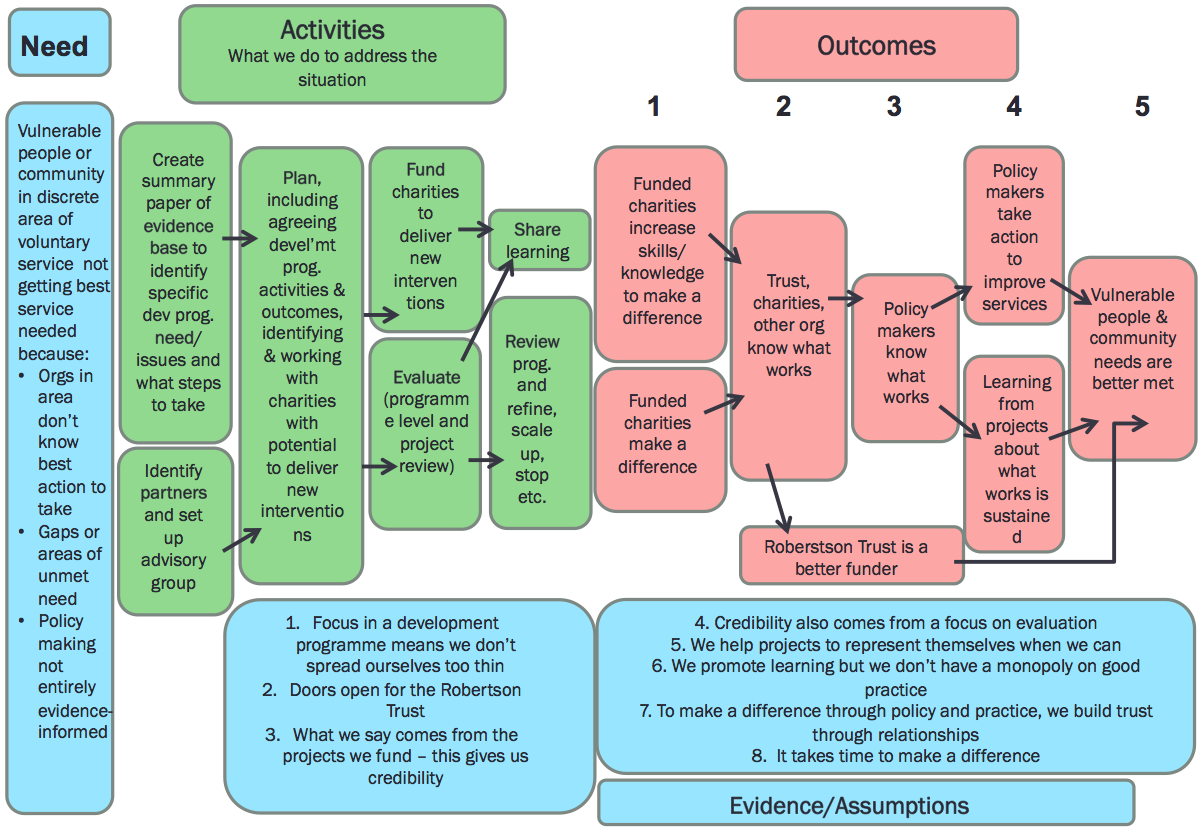The 5 Step Approach to Evaluation: Designing and Evaluating Behaviour Change Interventions
Updated, easy-to-use guidance describing how to use the 5 Step approach to design and evaluate behaviour change interventions.
Step 3: Draw a logic model
Show how the project should work:
Clear links between resources, activities and outcomes
What are logic models?
Logic models are step-by-step diagrams which simply show:
- What you're hoping to achieve in the long run (long-term outcomes)
- The process (short and medium term outcomes) through which your planned activities can be expected to lead to long-term aims.
- What resources will you need to do this (inputs)
Who can use them?
Anyone who is planning activities with particular aims in mind can benefit from using a logic model. This includes funders and commissioners, who might use them to plan how to assess applications and allocate funds in pursuit of their overall aims, as well as organisations and individuals planning behaviour change projects or services.
A very simple,evidence-based logic model
A very simple logic model for curing a headache:

Why use logic models?
Because logic models force you to be specific about what you're hoping to achieve and how, step by step, you're going to get there, they are helpful in a number of ways:
1. Planning: Are we clear what we plan to do and why we're doing it?
2. Monitoring performance: Are activities being delivered as you hoped?
3. Continual improvement: Are these activities working (for everyone)? Could we do things better?
4. Transparency: Does everyone within the organisation, and stakeholders outside of it, understand what we're doing and why we're doing it?
5. Evaluation: How successful were we in achieving our aims? Did our model work as expected?
A logic model template to use

This blank template can be found here
http://www.uwex.edu/ces/pdande/evaluation/evallogicmodel.html
Logic model column content: A quick guide
| Situation/Priorities: | What is the existing need/problem you are aiming to address? |
|---|---|
| Input: | What you need to invest (money, what evidence was embedded, materials, equipment, venue, technology, partners) |
| Activities: | What you do (e.g. conduct workshops, meetings, sessions, develop resources, assess, facilitate, provide one to-one support) |
| Participation: | Who you reach (e.g. users, clients, agencies, decision-makers, customers) |
| Short term outcomes: | What change happened in the short term? (e.g. awareness, learning, knowledge, skills, attitudes, motivations, aspirations, opinions) |
| Medium term outcomes: | What change happened in the medium term - ACTION (e.g. Practice and demonstrate new skills, behaviour, decision-making, policy change, social action) |
| Long term outcomes: | What is the ultimate outcome? (e.g. social change, economic change) |
| Assumptions: | (Linked to your review of the evidence) what assumptions need to be true in order for your model to work? |
| External factors: | What other factors will influence whether or not your outcomes are achieved? (e.g. economic conditions, local facilities, family context) |
A high level funding logic model
Logic models can be a valuable tool at every stage of planning and delivery of projects and services.
The logic model shows an example of how they can be used by funders to plan their activities. This example is a generic framework developed by the Robertson Trust.

A project-level logic model
The following logic model shows how a fictitious project, aimed to increase young women's physical activity levels is expected to work. It is based on international evidence about 'what works' to promote active lifestyles, particularly for young women (see image below). It shows clear links between activities and the expected outcomes, based on what research studies tells us.
This model is quite general, "real life" service providers should be a bit more detailed about the evidence they have used to design and deliver the intervention and also describe the content of activities in more detail.

Contact
There is a problem
Thanks for your feedback